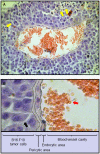The tumor microenvironment: a pitch for multiple players
- PMID: 23616948
- PMCID: PMC3628362
- DOI: 10.3389/fonc.2013.00090
The tumor microenvironment: a pitch for multiple players
Abstract
The cancer microenvironment may be conceptually regarded as a pitch where the main players are resident and non-resident cellular components, each covering a defined role and interconnected by a complex network of soluble mediators. The crosstalk between these cells and the tumor cells within this environment crucially determines the fate of tumor progression. Immune cells that infiltrate the tumor bed are transported there by blood circulation and exert a variety of effects, either counteracting or favoring tumor outgrowth. Here, we review and discuss the multiple populations composing the tumor bed, with special focus on immune cells subsets that positively or negatively dictate neoplastic progression. In this scenario, the contribution of cancer stem cells within the tumor microenvironment will also be discussed. Finally, we illustrate recent advances on new integrated approaches to investigate the tumor microenvironment in vitro.
Keywords: NK cells; T lymphocytes; cancer stem cells; dendritic cells; macrophages; myeloid-derived suppressor cells; solid tumors; tumor microenvironment.
Figures


References
-
- Afonina I. S., Cullen S. P., Martin S. J. (2010). Cytotoxic and non-cytotoxic roles of the CTL/NK protease granzyme B. Immunol. Rev. 235, 105–116 - PubMed
LinkOut - more resources
Full Text Sources
Other Literature Sources

